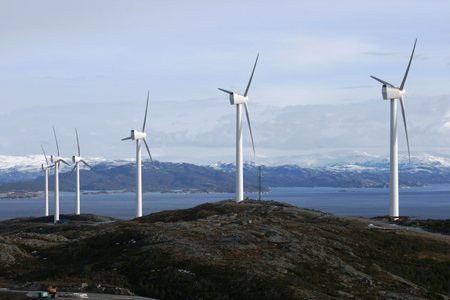With the recent revelation that the ultimate Washington insider, Jon Corzine, appears to have ordered the looting of hundreds of millions of dollars from customers at commodity broker MF Global, you would think crony capitalists would try to keep a low profile. But after only a weekend of contrived outrage, our elected leader seem to have returned to business as usual with a bipartisan group of Senators, including Mark Udall (D-CO), Michael Bennet (D-CO), Chuck Grassley (R-Iowa), Scott Brown (R-MA) and Dean Heller (R-Nevada), introducing legislation to extend for another two years the subsidies for wind power, labeled deceptively as “The American Energy and Job Promotion Act.” The real message coming from the U.S. Congress to taxpayers is: “we need either less corruption or more chances to participate in it.”
Windmills have been around for hundreds of years to lift well water and grind grain, but the father of the recent renewable energy scam is none other than Kenneth Lay, the infamous former CEO of Enron. In January 1997, Enron acquired Zond Corporation of California, the largest developer of wind-powered electricity at the time. Enron then lobbied the State of Texas to enact a broad electricity restructuring bill with a “renewable portfolio standard” that mandated that private electric utilities buy a minimum 2,000 mega-watts of qualifying renewable energy by 2009 and 10,000 mega-watts by 2025. Enron also lobbied Congress to successfully amend Title XXII of the Energy Policy Act of 1992 to direct the federal government to authorize tax incentives for renewable wind energy technologies.
Mr. Lay’s wheeling and dealing eventually drove the Enron leveraged empire into bankruptcy court four years later. His scams cost investors $10 billion dollars and over 20,000 employees lost their jobs and retirement benefits in the largest bankruptcy in American history. Mr. Lay died prior to facing a possible life sentence for his crimes, but Enron’s crony tax credits, mandates, and regulations did not die with him. In May of 2002, General Electric acquired Enron Wind Systems and renamed it GE Wind Energy.
GE’s corporate motto is “Imagination”, but it was lobbying muscle that drove wind power. GE’s $23 million lobbying in 2005 was rewarded with Congressional passage of the Energy Policy Act of 2005 that provided new tax incentives and loan guarantees for renewable energy. As GE lobbying rose to $26 million in 2009, Congress amended Section 406, the Energy Policy Act of 2005 authorizes loan guarantees to wind power as an “innovative technology that avoid greenhouse gases.” In 2010, GE lobbying soared to $39 million as the American Recovery and Reinvestment Act of 2009 spiked Congressional funding to $27.2 billion in grants for renewable energy.
Wind power has so much in the way of an accelerated depreciation tax break, production tax credits, and renewable energy credits that GE has been able to recoup its capital investments within a few years. The concept of actually selling power is far down the list of priorities for wind power. Electricity usage peaks in the cold winter and the hot summer, yet wind tends to blow the hardest in the low usage spring and fall. Consequently, electric utilities must traditionally have fuel power plants ready at all times to cover 100% of electricity demand. But under law, if wind turbines do begin spinning, the utilities are required to pay approximately twice the going rate for any wind power that is transmitted to their power grid.
A good example of the economic silliness of “wind farming” takes place along the Columbia River Gorge where there are a high number of wind turbines. The local electrical operator is Bonneville Power Authority (BPA). Last year, BPA had to shut down the wind farms for nearly 200 hours over 38 days. By law, Bonneville is required to compensate wind companies for half of their lost revenue. This year’s rebate bill could reach up to $50 million a year.
The extension of the crony renewable energy subsidies were originally buried deep in the legislation authorizing the Keystone XL pipeline, but the Senate rejected the measure on a largely party-line vote. According to the U.S. Energy Information Agency statistics, wind energy subsidies exceeded the subsidies of all other conventional sources of electricity, combined. The Keystone XL pipeline bill failed because it would have brought cheap and abundant power to most Americans. The American Energy and Job Promotion Act seems to be headed for easy passage, because it brings abundant amounts of subsidies to GE and other huge multi-national insiders.

COMMENTS
Please let us know if you're having issues with commenting.